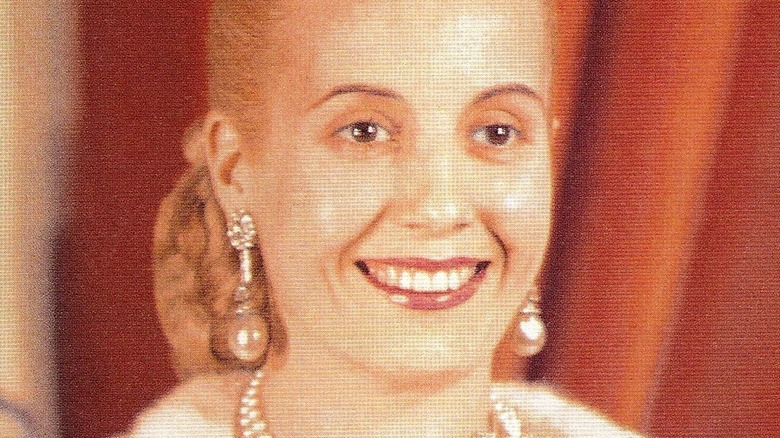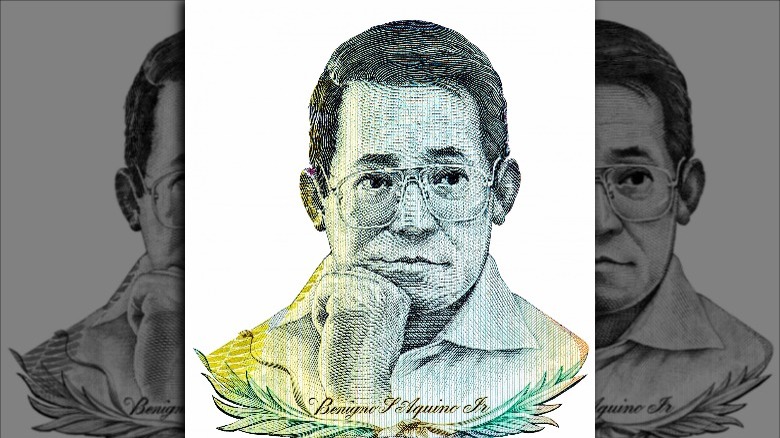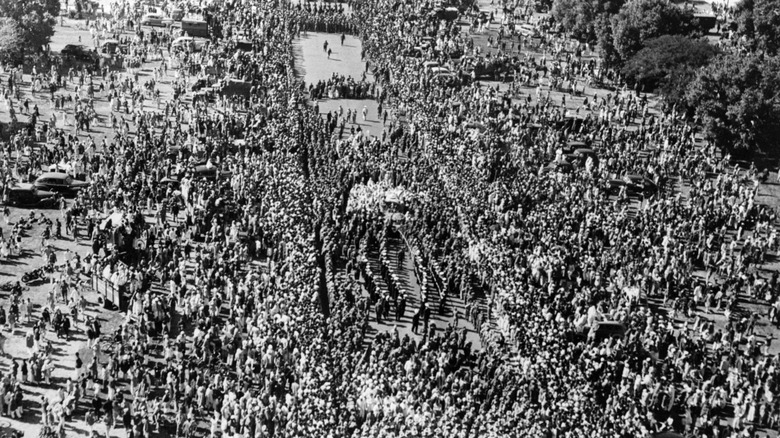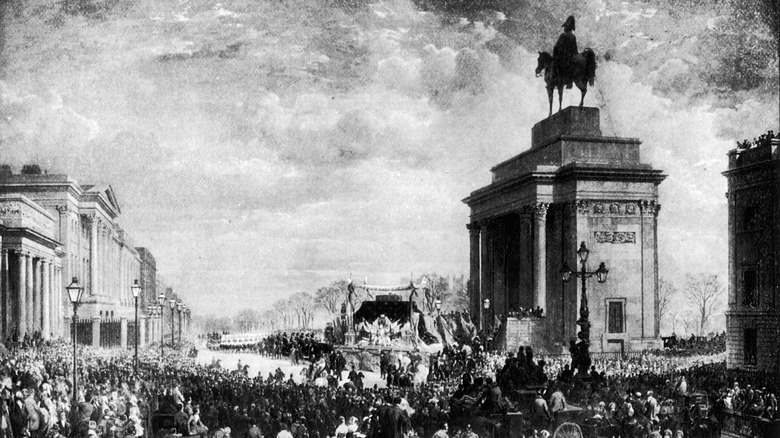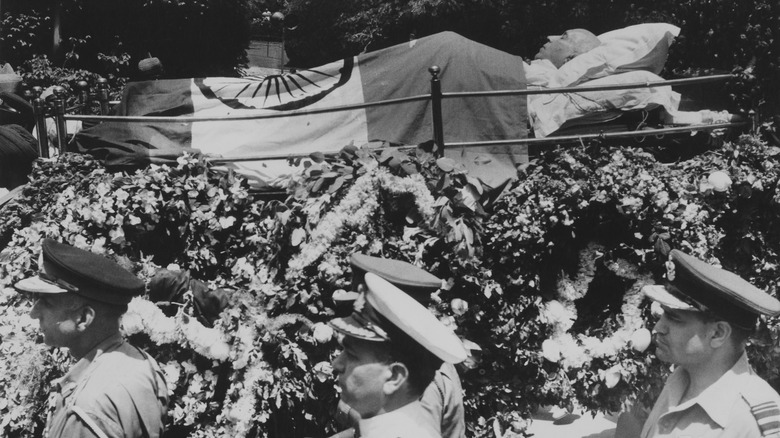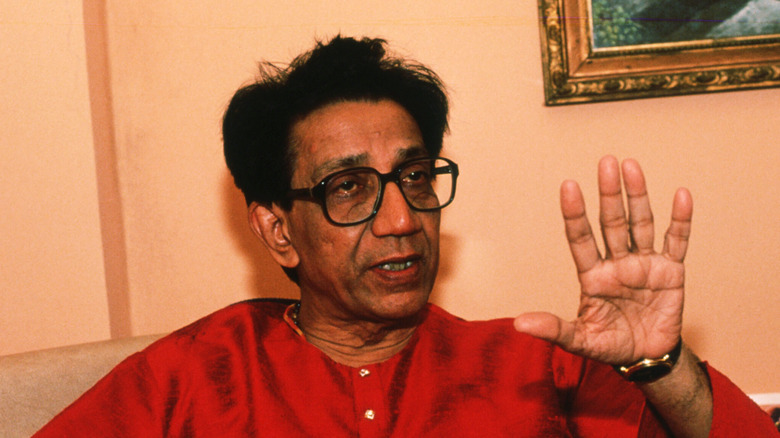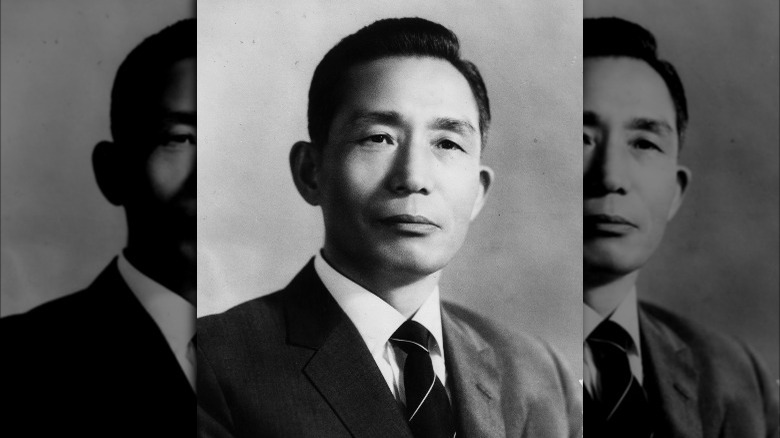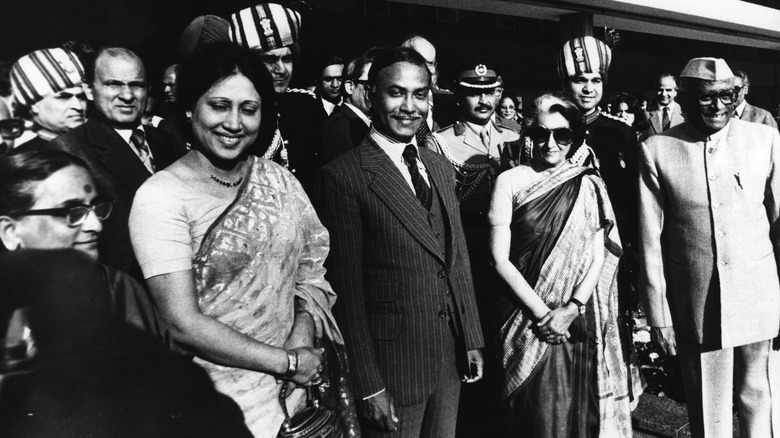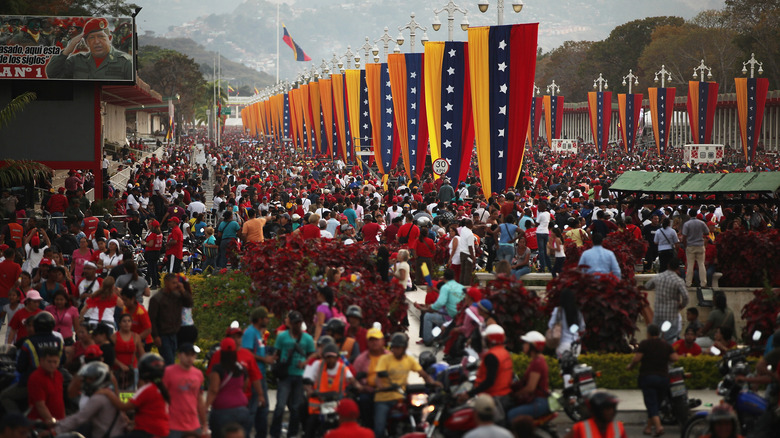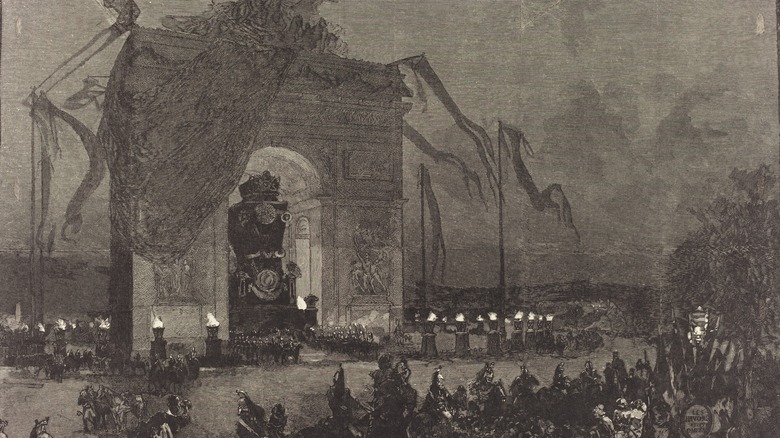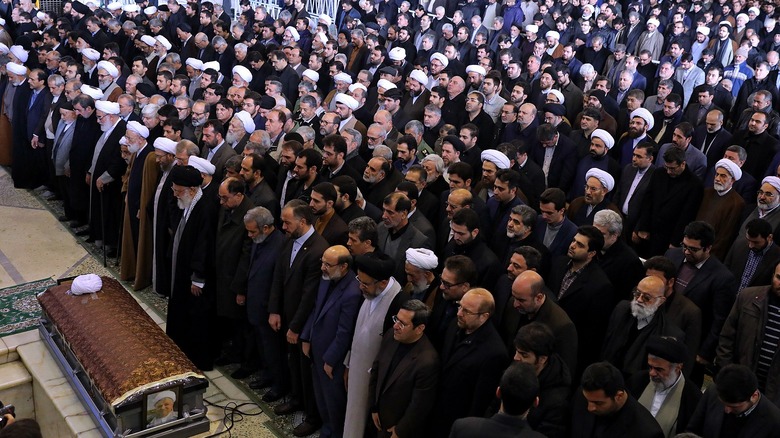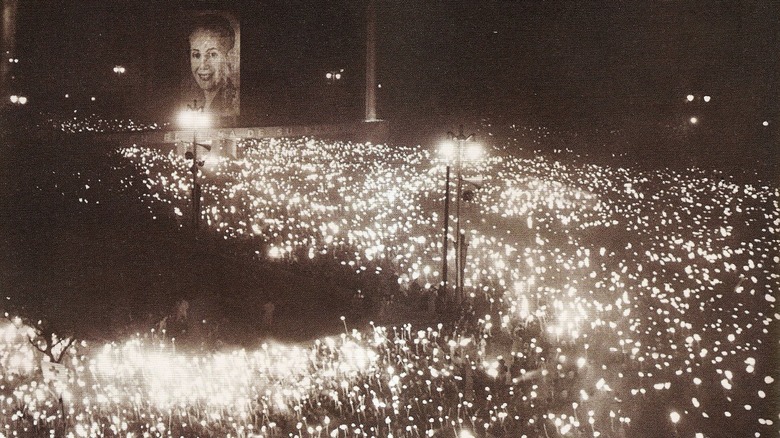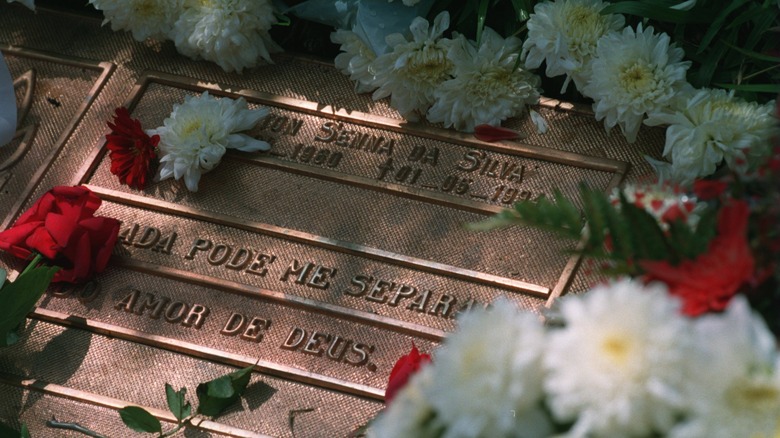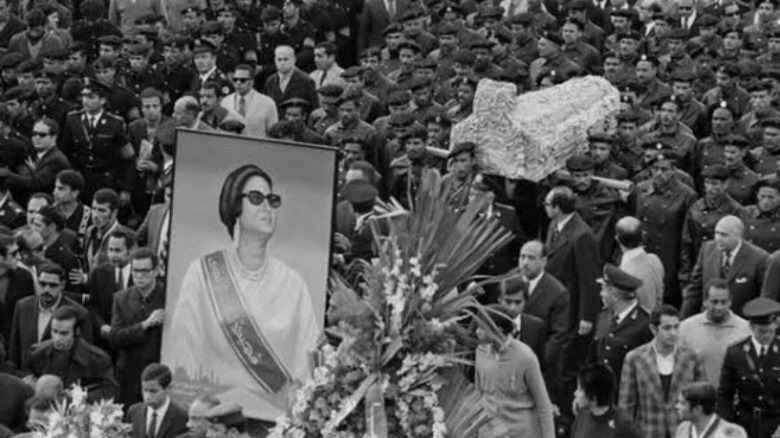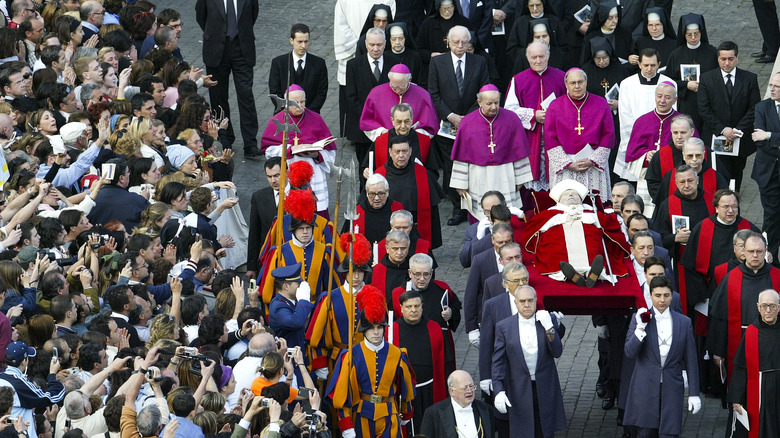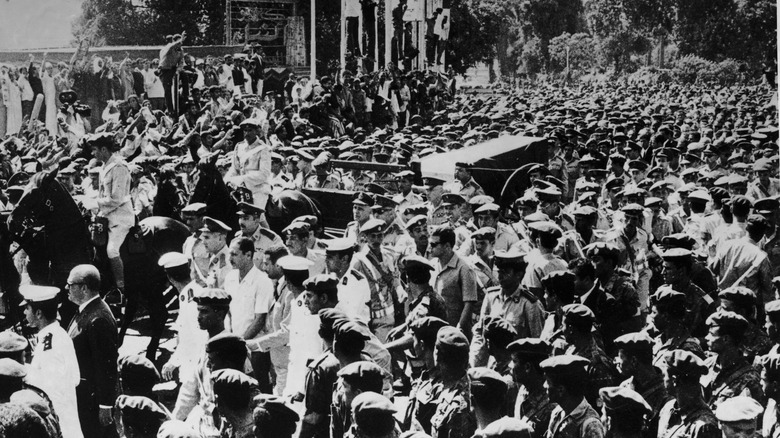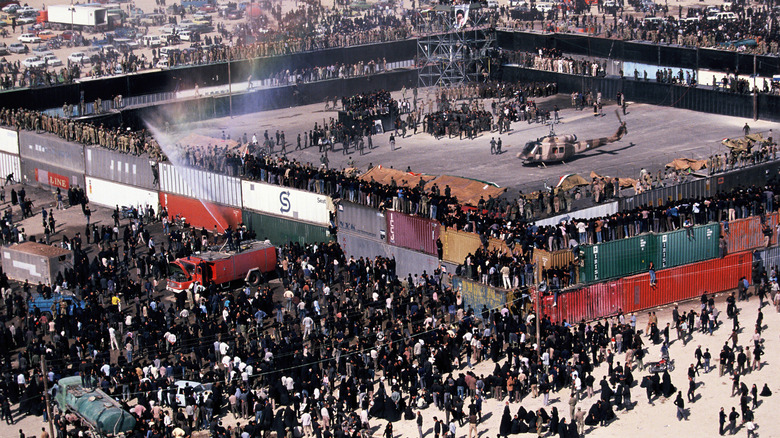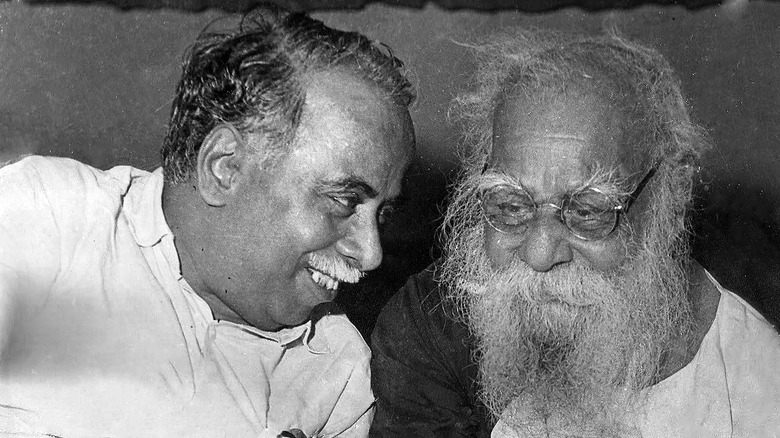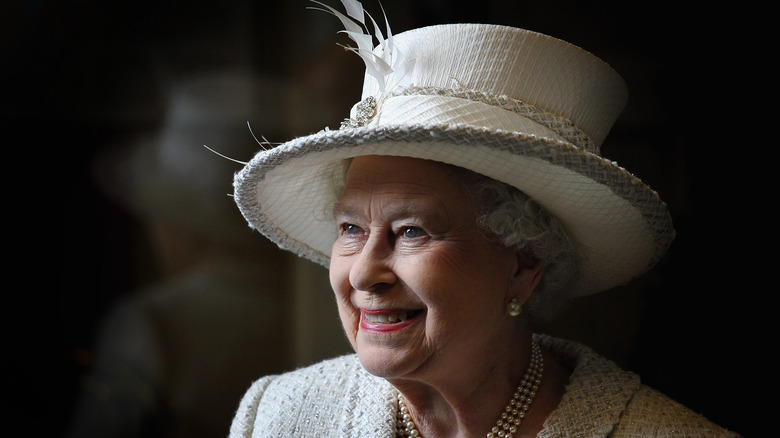The Biggest Funerals In History
Funerals are just this really sad truth of human life. Beginnings and endings and all of that; they're always somber occasions, memorable for all the worst reasons that surround loss. And... well, that's all really heavy (quite the start to one of these lists, isn't it?) So, it's time to move away from the extremely personal, and while any funeral is going to be a sad occasion, the funerals of people with celebrity-type status is something that's kind of interesting, because they really do end up being this whole other level above what you'd usually expect.
Sometimes, they can just be spectacular in a strange way, opulent and extravagant and expensive. Sometimes, you've got some strange stories to go along with them, either behind the scenes or as a result of the people who were there. Or, sometimes, they're just absolutely massive, thousands or millions of people crowded into narrow streets. Really, there's a good chance some of these kinds of epic funerals fall into multiple of those categories.
But for now, how about taking a look at some of the biggest funerals in all of history? The funerals with the highest number of people physically there to see the funeral or the funeral procession (which means omitting television audiences. Seriously, the numbers when TV gets involved get very big). And this includes a Guinness World Record holder, too, which boasts an impressively large stat.
Journalist and politician Benigno Aquino Jr.: 1-2 million
In 1983, upon returning to the Philippines from America, Senator Benigno Aquino Jr. was assassinated, shot behind the left ear after he'd just set foot on the tarmac at the Manila airport (via Washington Post). Suddenly, the opposition party had lost their leader, and the view of President Ferdinand E. Marcos — Aquino's long-time enemy — soured further as suspicions spread.
The New York Times reported that on the night of the funeral, some hundreds of students rushed to the capital in frustration, throwing rocks and crude bombs, only to be fought off by police (which ended in 18 injuries and a death). That wasn't the scene everywhere, though. Far from it. The funeral itself took place after a procession that lasted over 10 hours and wound across a 19-mile route on the outskirts of Manila. Somewhere between one and two million people lined that procession route (via Harvard Divinity School), occasionally getting a little rowdy and trying to force themselves past police lines. Some held signs that called out and vilified Marcos and the government, wanting justice for Aquino.
For the most part, the procession was completely peaceful, largely devoid of political messages, grief, or anger, even. There was singing and cheering as his coffin passed, people calling out his nickname — "Ninoy" — and saying that he wasn't alone. On the whole, it was a really positive celebration of the man who "personified the Filipino's courage in the face of oppression."
Spiritual leader Mahatma Gandhi: 1-2 million
Gandhi really doesn't need much of an introduction. As the man largely credited with Indian independence from Britain who also utilized a famous nonviolent civil disobedience (via The New Yorker), Gandhi is among some of the most important political leaders of the 20th century.
And so when he was suddenly assassinated in 1948 by a Hindu fanatic, the nation was shocked (via History Today). Jatinder Sethi wrote in India of the Past that he recalled hearing the news of Gandhi's death, feeling stunned into silence and just about disbelieving it. Shortly after, Gandhi's body was placed in a mansion called Birla House, where people could pass through and pay homage; thousands of people lined up and waited through the night to be able to do just that (via The Indian Express).
But that didn't really make the shock go away. The procession route was about five miles long and lasted for around five hours, with one or two million (depending on the source) people lining the streets, so densely packed that in photos, you can't see the ground between all of the mourners. And, unlike some other large funerals, this seemed to be a quietly somber affair. All of those people walked along the procession, alongside their beloved leader, silently crying, no one complaining about the walk or leaving part way through. The heavy melancholy really seems to be the main feeling here, so impactful that Sethi claimed that even looking at pictures decades later could bring back "that deathly silence mode."
Arthur Wellesley, Duke of Wellington: 1.5 million
Despite a humble birth, Arthur Wellesley, the first Duke of Wellington rose to become one of the most prominent military leaders of his time (via Branch). Fighting in the Napoleonic Wars and winning against steep odds, he really distinguished himself as a hero by being one of the leading figures in Napoleon's defeat at Waterloo. His reputation upon returning to England was much less impressive, though, as he cared little for the plight of the poor in newly-industrialized Victorian England.
Nonetheless, his funeral in 1852 was a spectacle the level of which had never been seen before. Huge and ridiculously opulent funerals were a thing in England at the time, regardless of social status, and Wellesley's funeral was the pinnacle of that, literally no expense spared for it. Tens of thousands of pounds went into an 11-ton bronze funeral car with lavish decorations, thousands of newly-installed lights, a Roman funeral arch for the procession to pass under, and merchandise. Yeah, literal merchandise for Wellesley; his death was commercialized and kept in the public eye for months.
About 1.5 million people arrived to watch the miles-long procession, bearing the dreary and stormy weather for a few hours, and despite the lavishness (which some accepted and others absolutely detested), the entire affair was really pretty solemn and orderly.
Indian Prime Minister Jawaharlal Nehru: 1.5 million
Shortly after India gained its independence from Britain, Jawaharlal Nehru, already a politician who had advocated for independence, was elected as the first prime minister of India (via History). He won the respect of many Indians and world leaders alike, implementing a lot of social reforms to better the lives of women and children, while also advocating further advancement in industrial, scientific, and technological fields. Unfortunately, Cold War conflicts took a toll on his health, and led to his death in 1964.
After his 17 years in office, mourners came out in droves, the New York Times reporting about 1.5 million of them all along the six mile procession route. Officials and dignitaries, both domestic and foreign, were in attendance, and the whole thing was just a pretty somber affair. Nehru had already been suffering health problems, and so his death didn't come as much of a surprise, while also happening at a time when India was experiencing a period of relative stability. And so the funeral seemed to fit that: mournful, but accepting and generally quiet.
Of course, there were some accounts of unrest, four people killed as they strained against and broke through police lines, and about 100,000 others pressing up against police lines as the procession came to an end. Overall, though, it seemed like a quiet and respectful funeral, despite its huge size.
Shiv Sena founder Bal Thackeray: 1.5 million
In the world of Indian politics, Bal Thackeray was a controversial figure. The founder of the Shiv Sena party — and the one who was largely responsible for its prominence as a Hindu nationalist movement — Thackeray was both loved and feared (via CNN). He'd been behind the renaming of Bombay to Mumbai, breaking away from its colonial past (via BBC). But at the same time, he was also blamed heavily for inciting tensions and brewing conflict between Hindus and Muslims.
So, yeah, that's a mixed bag, but his followers absolutely loved him. And that meant that when news came of his death in 2012, they refused to believe it (via The Hindu). It didn't quite seem real, and his followers began to feel lost without him to lead them. Eventually, though, reality and mourning set in as shops and businesses closed down.
When it came to the funeral, somewhere around two million people were expected, and the guess turned out not to be that far off. Indian media reported that about 1.5 million people did fill the streets and crowd close together, a dense sea of humanity surrounding the car that carried his body through the city.
South Korean President Park Chung-hee: 2 million
Following the split that created the two countries of North and South Korea, times were tough. Most of the country's industry was in the area that became North Korea, leaving South Korea an underwhelming and largely agricultural nation (via New York Times). But under President Park Chung-hee, the country blossomed, rising out of poverty and becoming a respectable industrial power. Well-respected by foreign powers, his death came as a shock, the result of a sudden assassination in 1979.
A week of official mourning was announced, and a third of the country spent that week burning incense and paying their respects (via New York Times).
After that week came the funeral, attended by dignitaries and representatives from 41 different countries. The procession itself lasted about six hours and wound through the streets of Seoul, the closed casket adorned with flowers and easily visible to those who attended. An estimated two million people lined the foggy streets to say their last goodbyes, weeping as the procession passed by.
Bangladeshi President Ziaur Rahman: 2 million
Originally enlisted as a soldier in Pakistan's army, Oxford Reference credits Ziaur Rahman as the principal leader in an uprising that led to Bangladesh's independence from Pakistan. Upon returning home and through a series of coups, Rahman became the president of Bangladesh, and a popular president at that, despite being generally classified as authoritarian.
He died pretty young, though, the result of an assassination in 1981 by a resentful rebel commander who was acting on personal, rather than political, motives, according to the Washington Post. People at the time feared what his death would mean for the future in terms of the old political feuds it could reopen, or the continuation of the slow but steady economic progress that the country had been seeing.
But aside from the political ramifications, the people also mourned, and the Pittsburgh Press reported nearly two million people gathering in the capitol, pouring through the streets. The gathering here wasn't calm, though, with some of Rahman's supporters fighting against the procession and trying to take the coffin away — something that they weren't successful in doing. All that came of that was officials calling in the military for further assistance, and a death among the people who had crowded into the Parliament building to see the coffin.
Venezuelan President Hugo Chavez: 2 million
Hugo Chavez was a controversial figure, to put it lightly. As the BBC says, he was pretty divisive, heavily vilified as a dictator for his socialist revolution in Venezuela. At the same time, though, during his 14 years as the leader of Venezuela, a lot of the poor really praised him for working toward Latin American unity and funding social projects.
All that praise and love from the people was pretty clearly on display when it came to his funeral in 2013, where his coffin was presented with the sword of Simon Bolivar. His body was left in state to be viewed by any who wanted to pay their respects, and the people answered that, two million of them filing by, sometimes after waiting for up to 26 hours for the opportunity, according to Reuters. Some mourners sobbed at seeing him and didn't know how to express their sorrow, feeling that they owed everything that they had to him. Others remembered his political victories, calling him invincible and undefeated. And then there were the cries that "Chavez did not die, he multiplied!" and that "The struggle continues!" The outpouring of emotion after Chavez's death is hard to dispute, and people wanted him eventually interred alongside Simon Bolivar himself.
That said, though, the cry that "The struggle continues!" really did seem true, as the future was left pretty murky, with the upcoming elections treading on shaky legal grounds and Cuba beginning to meddle in Venezuelan affairs.
Les Misérables author Victor Hugo: 2 million
You've heard of "Les Misérables," right? You know, that musical where you hear the people sing about revolution, oppression, and justice, adapted from the novel written by Victor Hugo. As ISR puts it, Hugo was the hero of the working class. His writings embodied the revolutionary spirit with stories of heroism and humanity, inspiring the poor and oppressed. So, fittingly, when he died in May 1885, he'd requested a poor man's funeral.
But that didn't happen. The French government knew his death would draw crowds and prepared accordingly, placing his body under the Arc de Triomphe, on a raised platform almost half the height of the arch itself (via The Sydney Morning Herald). Electric lights, torches, funeral urns, and streetlamps lit with green flames sat at the base.
The government was right to set up such a spectacle, because over two million people showed up — more than the entire population of Paris at the time. So there wasn't a single empty chair or empty table, with people flooding the streets at midnight and camping out. In the end, it became a big party, crowds made up of workers and the poor drinking and singing through the night, their cups always kept full thanks to the wine shops that stayed open, or the waiters walking the streets with more drinks. Those same people climbed trees and buildings to get a better view of the five-mile-long procession, filled with everything from suffragettes to gymnasts.
Iranian President Akbar Hashemi Rafsanjani: 2.5 million
Originally a revolutionary who took part in the 1979 revolution in Iran, Akbar Hashemi Rafsanjani later went a very different route, far from his revolutionary origins, according to The Guardian. Instead, he advocated better relations with the West and served as a voice for the younger generations and middle class, seemingly the only person in government to do so (via New York Times).
At his state funeral in 2017, though, the government wanted to highlight his revolutionary past and brush off his reformist later life. But when some 2.5 million people arrived for his funeral (the biggest crowd since Ruhollah Khomeini's funeral years earlier), his supporters made their views clear. Protestors gathered in front of the University of Tehran, yelling and drowning out the government officials by shouting opposition slogans, loud enough that officials had to raise the volume of the loudspeakers and audio engineers tried to mess with the sound to try and hide the voices of the protestors. Not that they were met with much success on that front.
An interesting part of this, though? Even his political opponents were vocal in their sadness over his death (via Aljazeera). The people who attended the funeral fell all across the political spectrum (though officials did try to keep certain political opponents away). And the White House also sent condolences – completely unprecedented and unexpected, considering ties between Iran and the US had been severed for nearly 40 years.
Argentinian First Lady Eva Peron: 3 million
The wife of Argentinian President Juan Peron, Eva Peron had always wanted to make something of herself, as an article in American Funeral Director says, and by marrying the man who would become president, she had the platform to do just that. Using her power, she championed social issues by helping the poor and needy, building hospitals, and getting women the right to vote, and her supporters absolutely loved her, seeing "Evita" as the closest thing they had to a saint.
So when she died in July 1952 at just 33-years-old, the entire country mourned. (Literally. The next month was designated as a period of national mourning.) Her body was later put on display and during those two weeks, some three million people waited in up to 15-hour-long lines to file past and pay their respects. Tens of thousands passed by every day, kissing the glass cover, fainting, and weeping, with nurses constantly on standby in case anyone needed medical assistance (some did, and there were more than a few deaths recorded). Once those two weeks were up, the day of her funeral procession arrived, her body loaded onto a specially made gun carriage while two million people lined the streets, flowers being thrown down from balconies overhead while Air Force planes flew above.
Her body wasn't immediately buried though, and instead went on a weird trip around the world before she was eventually brought back to Argentina in 1974, over two decades later.
Formula 1 driver Ayrton Senna: 3 million
Anyone who knows racing has probably heard this name, and Vice sums up who Ayrton Senna was: a Formula 1 world champion. Not only the best of his generation, but also a legend in the sport who's widely considered to be one of the best of all time. But a tragic figure, too, dying in 1994 in a brutal crash that was televised around the world. His death hit the racing community — and his home country of Brazil — hard.
Autoweek reports that the Brazilian government declared three days of national mourning, and when Senna's body was flown back home, at least a million people were waiting at the airport. The procession wove through the city as three million people lined the streets to watch, united in grief. And once that procession came to a stop, the people formed a line three miles long to be able to pay their respects; a lot of younger fans had inked his name on their foreheads, while others would blow kisses or offer prayers and gifts after waiting for around seven hours to do so. Among the mourners were other huge names in racing: Alain Prost, Emerson and Christian Fittipaldi, Frank Williams, just to name a few.
Outside, the banners had a single word printed on them: "saudade." It doesn't translate directly into English, but The Guardian explains it as "the sense of loss and sadness you feel when the person you love isn't there anymore."
Singer Umm Kulthum: 4 million
One of the few on this list who wasn't some sort of political leader, Umm Kulthum was a singer and artist beloved in a way that The Guardian says is pretty much unmatched in the western world. Hailed as "the star of the east" and "Egypt's fourth pyramid," Kulthum was one of the most famous singers of her time. But she was more than just a popular singer. She rejected the social norms of the period and managed to appeal to anyone, regardless of their status. At the same time, she embodied and supported a pan-Arab unity, bringing people together so well that the president at the time would deliver speeches right after her televised concerts.
Just about everyone loved her, so when she died in 1975, about four million people arrived to pay their respects, coming from all walks of life. The procession route was planned long in advance, and traffic shut down hours before it started. But those plans ultimately didn't really matter, with the New York Times reporting that those mourners broke through the police lines to gather behind the coffin, chanting "Farewell to the lady!" And the derivation from the plans went way further than that, the officials actually giving up power in the procession to the people themselves, who took the coffin and carried it along their own route, taking a detour to march through the poor quarter of the city before her body was delivered to the cemetery for burial.
Pope John Paul II: 4 million
Considering how widespread religion is in society in general, is it really surprising that, eventually, a pope would end up on this list? In this case, that's Pope John Paul II (via NBC News). The funeral took place in 2005 and pulled in millions of people from around the world. In the days leading up to the funeral, two million pilgrims filed through St. Peter's Basilica to view the pope's body. Then, when the funeral itself came, four million pilgrims flooded into Rome, about doubling the city's population. Many of them tried to pack themselves into the Vatican, and ultimately, around 300,000 of them fit within St. Peter's Square and Via della Conciliazione (via Irish Times). Millions of others watched from video screens set up all across Rome, and calls could be heard for the pope to immediately be given sainthood: "Santo! Santo subito!"
The Mass itself lasted two and a half hours, with Cardinal Joseph Ratzinger's speech being interrupted by applause at least 10 times, and the ceremony ended with a private burial in the Vatican crypts.
But what's really interesting though, aside from the sheer numbers, is the way this funeral touched people worldwide. Among the millions in Rome, visitors from other countries raised their own flags from all over the world, dignitaries flew in from many different places around the globe — America, Syria, Iran, Jordan, Poland, Britain — and others watched the service from other continents, including Africa and Asia.
Egyptian President Gamal Abdel Nasser: 5 million
History tells the story of Gamal Abdel Nasser, the first president of Egypt who incited a military coup in 1952 to overthrow the European-aligned monarchy. Nasser was a highly and consistently popular politician during his 18 years in power, respected by leaders worldwide, embodying a spirit of pan-Arab unity, while also just improving the quality of life for the people he led.
So when he died in 1970, the people mourned. The state had planned a relatively small ceremony in Cairo with 40 major generals and 5,000 troops, as reported by BBC. The New York Times also reported that foreign dignitaries were also supposed to arrive (and did) to take part in the service. But that didn't go to plan at all, as five million people arrived and flocked around the six-mile-long procession route. Mourners fought against the police, trying to break through the lines as soldiers tried to push them back with their weapons. The radio did what they could to try and talk everyone down, but the people continued to fight, wanting to take the coffin, to see and kiss and carry it themselves. At that point, the dignitaries were advised to leave, and it became an event more for the people, thousands of whom waited just at the end of the procession route, waving handkerchiefs to say goodbye.
That said, the mourning wasn't limited to only Cairo, with many other cities around Egypt reporting incidents and similarly huge gatherings.
Ayatollah Ruhollah Khomeini: 6 million
In the 1970s, Ruhollah Khomeini completely shook up the political scene of Iran. According to BBC, Khomeini spoke out against the unpopular Shah, eventually convincing his followers to overthrow the government and becoming Iran's political and religious leader.
Ten years of rule came to an end with his death in 1989. The LA Times reported that almost all of Tehran's six million residents were there for the funeral, along with millions more from neighboring cities (though that exact number isn't mentioned), and that was after two million people had already kept a nightlong vigil. Those millions of people grieved the loss. Intensely. AP News says that people were beating their heads with their hands or throwing dust on themselves, symbolizing their desire to be buried with Khomeini as they cried out for their leader not to leave them. They just didn't want to see him buried.
But that wasn't the most dramatic thing to happen. At one point, the mourners stopped the 10-hour long procession entirely, reaching into the hearse and grabbing for Khomeini's body. They dragged it from the car and tore at the white shroud that covered him, trying to take pieces of what they saw as sacred relics. At one point, the body actually fell out of the coffin in the commotion and hit the ground. A helicopter had to be called in to retrieve the body, though even then, some people clung to the helicopter as it tried to take off.
Chief Minister of India C.N. Annadurai: 15 million
Considering the title of this article, it only seems fitting that the Guinness World Record holder for "most attended funeral" would be here. And that would be the 1969 funeral of C.N. Annadurai (pictured left). Annadurai was a chief minister of India, known for his skills as an orator and as a leader of the Dravidian movement (via FirstPost). His pragmatism kept the party alive, and he became something of a political icon.
And so after his death, millions flocked to Madras to pay their respects. And this wasn't one or two or three million; this was 15 million people all converging on a single city (via DTNext). Insane, right? The city set up special transportation and trains just to help people get there, but even that wasn't enough: most people traveling without a ticket and hitching a ride on top of those trains (with sometimes tragic results. Twenty-eight people died when the train passed across a bridge that had a roof over it). The streets were packed tight, so badly that VIPs couldn't get to the service, many other people hanging off of trees and buildings all along the six-kilometer procession route, chanting "Anna," over and over.
The funeral itself was actually really simple, only lasting about 15 minutes, but the wider effect on the city was insane. Madras just couldn't handle the influx of people, food prices skyrocketed, and hotels were completely overwhelmed. By the end, the city was, well, sort of trashed.
Queen Elizabeth II
After 70 years on the English throne, Queen Elizabeth II's death on September 8, 2022, was international news.
Her funeral was a fittingly huge event. Per The Washington Post, the funeral itself was directly attended by about 2,000 people in Westminster Alley, including heads of state and royalty from dozens of countries around the world. But that doesn't mean that the rest of Britain wasn't watching. On the contrary, Reuters says that most of the U.K. was tuning in from their homes; as reported, just under 33 million people watched at least a few minutes, and it's estimated that, at its peak, some 22 million were watching all at once. Then there are also the worldwide numbers to factor in, with about 11 million people watching from the U.S., and about the same amount watching at least a portion of it from Germany (via Variety). Though many of these numbers are estimates, Deadline suspects that, in total, the global audience was somewhere around 4 billion people.
But the funeral wasn't the only huge gathering for Queen Elizabeth II's death. As told by The Washington Post, her body was laid in state for four days in Westminster Abbey. Initial reports say that some 250,000 people were able to pay their respects, even with authorities capping the line once they realized that mourners were queueing for a full 24 hours. That decision didn't ultimately do much, though, with a secondary line forming just for people to try to get into the official line.
